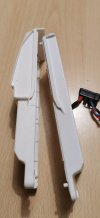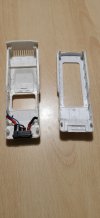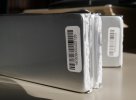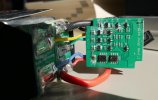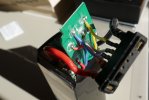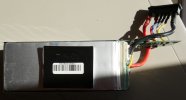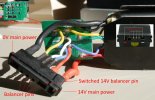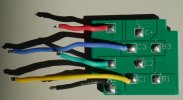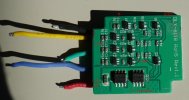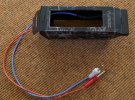You are using an out of date browser. It may not display this or other websites correctly.
You should upgrade or use an alternative browser.
You should upgrade or use an alternative browser.
Anyone disassembled a Yuneec 480 battery?
- Thread starter RTH
- Start date
I haven’t disassembled one, but be extremely careful in doing so. If you puncture a LiPo cell it can outgas and catch fire. Do it outside on a surface that is not prone to catching fire itself.
Thanks, I'm used to working with lipos and intend to do this outside especially as one or two are puffy pillows.I haven’t disassembled one, but be extremely careful in doing so. If you puncture a LiPo cell it can outgas and catch fire. Do it outside on a surface that is not prone to catching fire itself.
From looking at my packs for the H480 they appear to be sonic welded. If that is so, splitting them along the seam may take using a cutting wheel on a Dremel tool at the lowest speed possible to avoid melting. I have cut open other sonic welded parts using an X-acto knife, but would not try it on a battery pack. It is a very slow process with the knife also, but it allows the pieces to be glued together when reassembling as less material is removed.
Photos of your project would be nice to post if you don’t mind.
Photos of your project would be nice to post if you don’t mind.
Last edited:
Sure, I'll post pics when done.From looking at my packs for the H480 they appear to be sonic welded. If that is so, splitting them along the seam may take using a cutting wheel on a Dremel tool at the lowest speed possible to avoid melting. I have cut open other sonic welded parts using an X-acto knife, but would not try it on a battery pack. It is a very slow process with the knife also, but it allows the pieces to be glued together when reassembling as less material is removed.
Photos of your project would be nice to post if you don’t mind.
I was planning to use a scroll saw with a very fine blade to go almost fully through the plastic and a Dremel too where necessary, cutting a section along each axis to then sliding the cell pack out the back. Knowing how the pack is connected to the pins, ie how much if any cable length would be nice to know when planning. My hope would be that I leave enough cable in place to add a run of cable through the body to an external connector where I would load new packs in reverse allowing them to be plugged in from the outside....kind of like how its done in the 920 only with the guts flapping in the breeze.
Take a look at this thread The inside of the battery
I did it on a Chroma battery, I open it using a cutter, passing the blade several times along the joint line of the two shell of the of the housing.
I did it on a Chroma battery, I open it using a cutter, passing the blade several times along the joint line of the two shell of the of the housing.
Brilliant, thanks for the link, that tells me a lot. I might make an insertion on the 45˚ slope to disassemble and then slide all out the back. The battery I am planning to use has the same cross section, but is just a bit longer, so this should work well. Yea, it my saw is too aggressive, I might use a blade too. ThanksTake a look at this thread The inside of the battery
I did it on a Chroma battery, I open it using a cutter, passing the blade several times along the joint line of the two shell of the of the housing.
Great, thank you, thats a mighty write up, some bedtime reading, thanks.
h-elsner
Premium Pilot
- Joined
- Mar 23, 2016
- Messages
- 2,393
- Reaction score
- 2,153
- Location
- Bavaria / Germany
- Website
- h-elsner.mooo.com
- Joined
- Nov 17, 2018
- Messages
- 77
- Reaction score
- 28
- Age
- 54
Hope I'm not too late here to give you some cautionary advice. When you do your first test flight...... Stay low and prepare to land quickly if it appears your compass has lost its bearings. If this happens be prepared for a scary landing, you will be basically flying in manual without the GPS and compass help that you normally have. Try your first flight on a no wind day. What I have found with alternative batteries is the factory somehow calibrated it to accept the oem battery but not others. Not sure the exact reason. I have only found one battery that works good on its own and it happened to be the exact same weight and size as the factory battery. The solution I came up with, to allow the use of all alternative batteries without interfering with the compass GPS signal is an adapter that moves the GPS module out of the line of interference.
I have the adapter listed on eBay. Search Yuneec Typhoon H GPS adapter to see the one I have made. You could make your own adapter similar to the one on eBay or just buy that one. Also check my other items, I have an adapter like the one you are making, but I have made it into a one piece device that can stay in the drone while changing batteries, it also includes the GPS adapter.
Please report how your battery works, and be careful with your first flight.
I have the adapter listed on eBay. Search Yuneec Typhoon H GPS adapter to see the one I have made. You could make your own adapter similar to the one on eBay or just buy that one. Also check my other items, I have an adapter like the one you are making, but I have made it into a one piece device that can stay in the drone while changing batteries, it also includes the GPS adapter.
Please report how your battery works, and be careful with your first flight.
Thanks for the heads up, I think I may have seen your video or ebay page already. What you say ties in with my experience with a pair of powerextra batteries I used before realising it was only with them that I was getting compass/gps errors. From the little I know of compasses and GPS receivers I also can't imagine why this correlation might be caused, I don't think we are adding or subtracting any ferromagnetic material and the GPS receiver is positioned and shielded above all already.Hope I'm not too late here to give you some cautionary advice. When you do your first test flight...... Stay low and prepare to land quickly if it appears your compass has lost its bearings. If this happens be prepared for a scary landing, you will be basically flying in manual without the GPS and compass help that you normally have. Try your first flight on a no wind day. What I have found with alternative batteries is the factory somehow calibrated it to accept the oem battery but not others. Not sure the exact reason. I have only found one battery that works good on its own and it happened to be the exact same weight and size as the factory battery. The solution I came up with, to allow the use of all alternative batteries without interfering with the compass GPS signal is an adapter that moves the GPS module out of the line of interference.
I have the adapter listed on eBay. Search Yuneec Typhoon H GPS adapter to see the one I have made. You could make your own adapter similar to the one on eBay or just buy that one. Also check my other items, I have an adapter like the one you are making, but I have made it into a one piece device that can stay in the drone while changing batteries, it also includes the GPS adapter.
Please report how your battery works, and be careful with your first flight.
Either way, yes I'll wait till a no wind day, catching a H in the wind without GPS isn't easy done that before and don't want to have to practise it anymore.
- Joined
- Nov 17, 2018
- Messages
- 77
- Reaction score
- 28
- Age
- 54
I believe since they put air vents on both sides of the GPS module, and they cut holes in the shielding in those locations to let the hot air out?What you say ties in with my experience with a pair of powerextra batteries I used before realising it was only with them that I was getting compass/gps errors. From the little I know of compasses and GPS receivers I also can't imagine why this correlation might be caused, I don't think we are adding or subtracting any ferromagnetic material and the GPS receiver is positioned and shielded above all already.
I have thought maybe putting a "solid piece of shielding", that would block the air vents but completely shield the GPS, and cutting air vents somewhere else.
But that would look ugly. Lol
Similar threads
- Replies
- 4
- Views
- 2K
- Replies
- 1
- Views
- 223
- Replies
- 4
- Views
- 924
- Replies
- 19
- Views
- 659



